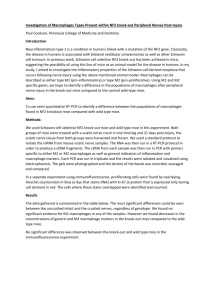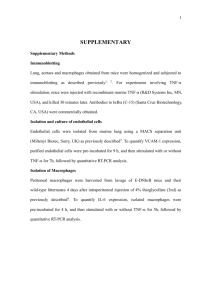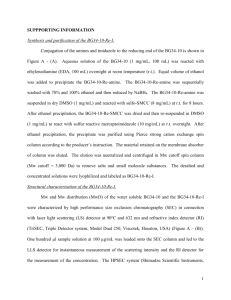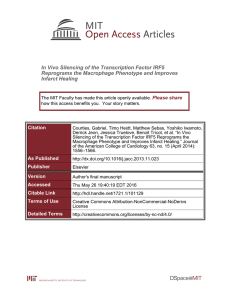Courties et al.: RNAi silencing in wound macrophages
advertisement
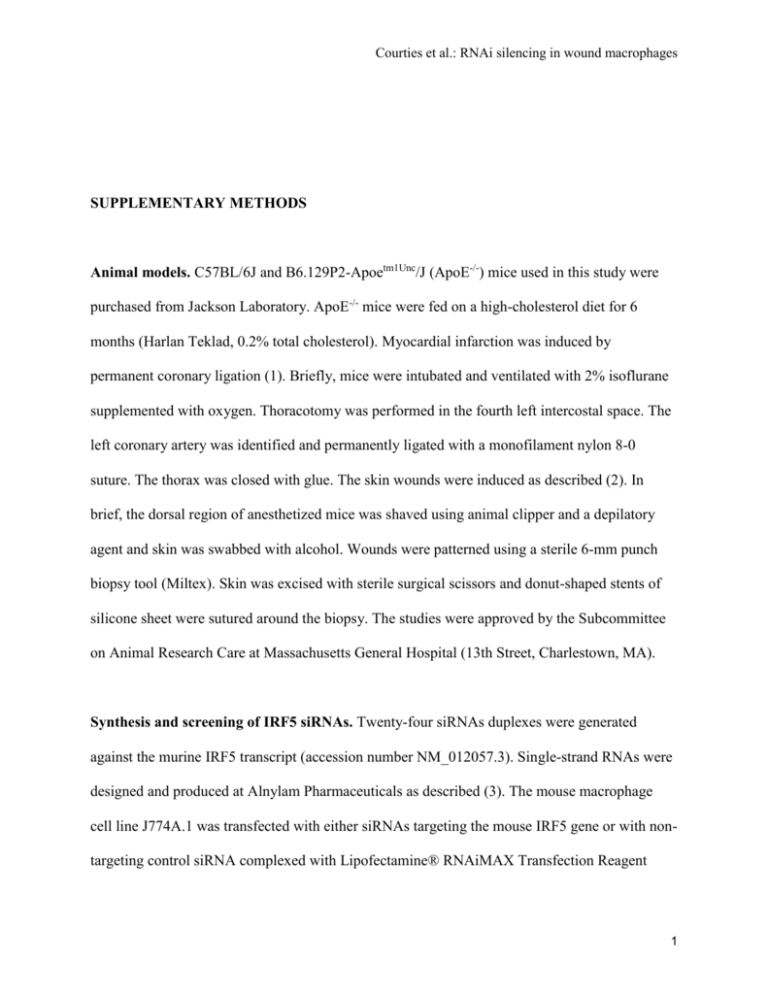
Courties et al.: RNAi silencing in wound macrophages SUPPLEMENTARY METHODS Animal models. C57BL/6J and B6.129P2-Apoetm1Unc/J (ApoE-/-) mice used in this study were purchased from Jackson Laboratory. ApoE-/- mice were fed on a high-cholesterol diet for 6 months (Harlan Teklad, 0.2% total cholesterol). Myocardial infarction was induced by permanent coronary ligation (1). Briefly, mice were intubated and ventilated with 2% isoflurane supplemented with oxygen. Thoracotomy was performed in the fourth left intercostal space. The left coronary artery was identified and permanently ligated with a monofilament nylon 8-0 suture. The thorax was closed with glue. The skin wounds were induced as described (2). In brief, the dorsal region of anesthetized mice was shaved using animal clipper and a depilatory agent and skin was swabbed with alcohol. Wounds were patterned using a sterile 6-mm punch biopsy tool (Miltex). Skin was excised with sterile surgical scissors and donut-shaped stents of silicone sheet were sutured around the biopsy. The studies were approved by the Subcommittee on Animal Research Care at Massachusetts General Hospital (13th Street, Charlestown, MA). Synthesis and screening of IRF5 siRNAs. Twenty-four siRNAs duplexes were generated against the murine IRF5 transcript (accession number NM_012057.3). Single-strand RNAs were designed and produced at Alnylam Pharmaceuticals as described (3). The mouse macrophage cell line J774A.1 was transfected with either siRNAs targeting the mouse IRF5 gene or with nontargeting control siRNA complexed with Lipofectamine® RNAiMAX Transfection Reagent 1 Courties et al.: RNAi silencing in wound macrophages (Invitrogen) at 0.1 nM and 10 nM final concentrations. Cells were harvested at 24 hours after transfection and expression levels of IRF5 mRNA were quantified by qRT-PCR using TaqMan primers. The following sequence of IRF5 siRNA was scaled up for in vivo studies : 5’cuGcAGAGAAuAAcccuGAdTsdT-3’ (sense), 5’-UcAGGGUuAUUCUCUGcAGdTsdT-3’ (antisense) wherein lower case letters identify 2’OMe modified nucleotides. Nanoparticle encapsulation was done as described previously (4, 5). Intravenous injection of siRNAs. Mice were anesthetized and injected through the tail vein with 0.5 mg/kg of either siIRF5 or with control siRNA targeting luciferase (siCON). For biodistribution studies, mice were injected with 1 mg/kg of Alexa Fluor-647 labeled siRNA lipid nanoparticles. Cell isolation and flow cytometry. To obtain single-cell suspensions from heart tissue, infarcts were excised, minced with a fine scissor prior to digestion in 450 U/ml collagenase I, 125 U/ml collagenase XI, 60 U/ml DNase I and 60 U/ml hyaluronidase (Sigma-Aldrich) for 1 hour at 37°C under agitation (750 rpm). Cells were then triturated through a 40µm nylon mesh (BD Falcon), washed and centrifuged (8 min, 300 g, 4°C). Cells were first stained with a cocktail of Phycoerythrin (PE) anti-mouse antibodies including CD90.2 (clone 53-2.1), CD19 (clone 1D3), NK1.1 (clone PK136), Ly-6G (clone 1A8) and Ter-119 (clone TER-119). Cells were then stained with anti-mouse CD11b (clone M1/70), F4/80 (clone BM8) and Ly6C (clone AL-21). Neutrophils were identified as (CD90.2/CD19/NK1.1/Ly-6G/Ter119)high, CD11bhigh. Ly-6Chigh monocytes were identified as (CD90.2/CD19/NK1.1/Ly-6G/Ter119)low, CD11bhigh, F4/80low, Ly- 2 Courties et al.: RNAi silencing in wound macrophages 6Chigh. Macrophages were identified as (CD90.2/CD19/NK1.1/Ly-6G/Ter119)low, CD11bhigh, F4/80high, Ly-6Clow. Isolation of cells from the heart. Depletion of undesired lymphocytes and granulocytes was performed using column-based magnetic cell sorting according to the manufacturer’s instructions (Miltenyi Biotec). Briefly, single cell suspensions were stained using a cocktail of PE-conjugated antibodies directed against CD90, CD19, NK1.1, Ter119 and Ly6G, followed by incubation with anti-PE Microbeads. The enrichment was evaluated by flow cytometry isolated monocytes/macrophages were used for downstream qRT-PCR and western blot analyses. Quantitative RT-PCR. Total messenger RNA (mRNA) was extracted using the RNeasy Micro Kit (Qiagen) according to manufacturer’s instructions. One microgram of mRNA was reverse transcribed using the high capacity RNA to cDNA kit (Applied Biosystems). TaqMan gene expression assays (Applied Biosystems) were used to quantify target genes. The relative changes were normalized to Gapdh mRNA using the 2-∆∆CT method. Western blots. Myeloid cells from heart tissue were isolated as described above, washed with ice-cold PBS and homogenized on ice using RIPA lysis buffer (Millipore) supplemented with complete protease inhibitor cocktail (Roche). Protein concentration was measured using BCA assay (Pierce). Samples of 15 µg were loaded on 10% SDS-PAGE and transferred onto PVDF membranes (Bio-Rad). Membranes were blocked with 5% non fat dry milk in TBS-Tween 0.1% and incubated with antibodies against IRF5 (Abcam, ab21689), and peroxidase-coupled antibodies as the secondary antibody (Abcam, ab6721). Gapdh or b-tubulin were used as 3 Courties et al.: RNAi silencing in wound macrophages controls. Signals were visualized with enhanced chemiluminescence detection system (ECL Plus, Amersham Life Science), and densitometric analysis was performed with ImageJ 1.40g (National Institutes of Health). TTC staining. The hearts were excised under a microscope and were then cut into myocardial rings of 1 mm thickness using a rodent heart slicer (Zivic Instruments), which were stained with 2-3-5-triphenyl tetrazolium chloride (TTC) to demarcate the infarct. Thereafter, the rings were scanned (HP Scanjet 4300). Fluorescence reflectance imaging (FRI). Heart slices were imaged using a planar fluorescent reflectance imaging system (OV-110, Olympus) with an excitation wavelength 680 nm. Light and near infrared fluorescence (NRIF) images were obtained with respective exposure times between 75 ms and 60 seconds. Animals were maintained under a continuous flow of 1-2% isoflurane in oxygen for maintenance of anesthesia throughout the imaging session. Fluorescence Molecular Tomography-Computed Tomography (FMT/CT). FMT imaging (680/700 nm excitation/ emission) was performed to investigate in vivo magnitude of inflammation in infarct wounds (6, 7). Five nmoles of a pan-cathepsin protease sensor (Prosense680) were injected i.v. 24 hours before imaging. A quantitative 3D dataset in which fluorescence per voxel was expressed in nM was reconstructed. FMT was followed by CT (Inveon PET-CT, Siemens) to identify anatomic regions. Contrast-enhanced X-ray computed tomography localized the infarcts. This anatomical information guided the placement of the volume of interest in the quantitative protease activity map concomitantly obtained by hybrid FMT. An imaging cartridge 4 Courties et al.: RNAi silencing in wound macrophages containing the anesthetized mouse was placed into a custom machined Plexiglas holder that supplies isoflurane during imaging. The CT x-ray source, with an exposure time of 370-400 ms, was operated at 80 kVp and 500 μA. During CT, isovue-370 was infused continuously at 20 μL/min through a tail vein catheter. The CT reconstruction protocol performed bilinear interpolation, using a Shepp-Logan filter, and scaled pixels to Hounsfield units. Image fusion relied on fiducial markers and used Osirix software (The Osirix Foundation, Geneva). Magnetic resonance imaging (MRI) In vivo MRI was performed on days 1 and 21 after coronary ligation. Cine images of the left ventricular short axis were obtained using a 7 Tesla horizontal bore Pharmascan (Bruker) and a custom-built mouse cardiac coil in birdcage design (Rapid Biomedical). Acquisition was done as described previously, using an ECG triggered and respiratory gated fast low angle shot sequence. The echo time was 2.7ms, and the flip angle 30 degrees (60 degrees for delayed enhancement imaging after intravenous injection of Gd-DTPA for measurement of infarct size) (8). Image analysis was done using the software Segment (http://segment.heiberg.se) (9). Histology. To eliminate blood contamination, hearts were perfused with ice-cold PBS after mice were euthanized. Hearts were removed, rinsed in PBS, embedded in O.C.T. compound (Sakura Finetek), and frozen in an isopentane bath on dry ice. For immunofluorescence staining, sections (5 μm) were either stained with anti-CD11b antibody (clone M1/70, BD Biosciences) followed by a biotinylated anti-rat secondary antibody and fluorescein streptavidin (Vector Laboratories, Inc.) or co-stained with the TUNEL reagents (DeadEnd Fluorometric TUNEL System, Promega) and then incubated with a rat anti-mouse MAC-3 antibody. Streptavidin-DyLight594 (Vector 5 Courties et al.: RNAi silencing in wound macrophages Laboratories, Inc) was used to detect the MAC-3 antibody. The slides were cover slipped using a mounting medium with DAPI (Vector Laboratories, Inc.) to identify nuclei. Images were observed and captured using Nikon Eclipse 80i with a Cascade Model 512 B camera (Roper Scientific). For immunohistochemistry, histology of the heart was performed on day 7 after MI in ApoE-/- mice. Frozen sections (5 μm) were stained for neutrophils (NIMPR14, Santa Cruz Biotechnology, Inc.), monocytes (CD11b, M1/70, BD Biosciences), macrophages (MAC-3, M3/84 BD Biosciences), neovessels (PECAM-1, MEC13.3 BD Biosciences), and collagen deposition (Collagen I, Abcam), and smooth muscle cells (a-SMA, Abcam). The appropriate biotinylated secondary antibodies, ABC kit (Vector Laboratories, Inc.) and AEC substrate (Dako) were used for color development, and all the sections were counterstained with Harris hematoxylin. The slides were scanned by a digital slide scanner, NanoZoomer 2.0-RS in 40x high resolution mode (Hamamatsu, Japan). The positive area was quantified using IPLab (version 3.9.3; Scanalytics, Inc.) and analyzing five high power fields per section and per animal. Statistics. Data are expressed as mean ± sem. Analyses were performed using Prism 6.0a (GraphPad Software Inc.). The group means were compared using a t-test (for 2 groups) and ANOVA, followed by Bonferroni post-tests (for > 2 groups). P values of <0.05 indicate statistical significance. 6 Courties et al.: RNAi silencing in wound macrophages SUPPLEMENTARY DISCUSSION Why do we detect nanoparticle delivery to infarct macrophages in non-reperfused MI while the Evans blue method does not show dye distribution to the infarct in the same model? The Evans blue method uses digital photography (10), and hence light of the visible spectral wavelength, to detect poorly perfused myocardium downstream of the ligated coronary artery. Other techniques such as MRI detection of delayed infarct enhancement after injection of GdDTPA (Fig. 6A in main manuscript) or fluorescence sensing of a near infrared fluorochrome attached to siRNA (Fig. 2) do not rely on visible light. Near infrared imaging (11), near infrared microscopy and near infrared detection of fluorochromes inside single cells by FACS (as used in this paper, Fig. 2) are very sensitive techniques due to the high resolution, and because photons with wavelength in the near infrared are absorbed to a lesser extent in myoglobin-rich myocardium when compared to the visible light (12). In addition, fluorescence imaging uses long acquisition times and post-acquisition signal amplification to increase sensitivity. We hypothesize that if one would look for Evans blue in non-reperfused infarcts with a highly sensitive technique one could detect this small molecule dye, albeit at a much lower level when compared to non-infarcted myocardium. 7 Courties et al.: RNAi silencing in wound macrophages SUPPLEMENTARY REFERENCES 1. Nahrendorf M, Swirski FK, Aikawa E et al. The healing myocardium sequentially mobilizes two monocyte subsets with divergent and complementary functions. J Exp Med. 2007;204:3037–47. 2. Galiano RD, Michaels Jt, Dobryansky M, Levine JP, Gurtner GC. Quantitative and reproducible murine model of excisional wound healing. Wound Repair Regen. 2004;12:485–92. 3. Frank-Kamenetsky M, Grefhorst A, Anderson NN et al. Therapeutic RNAi targeting PCSK9 acutely lowers plasma cholesterol in rodents and LDL cholesterol in nonhuman primates. Proc Natl Acad Sci U S A. 2008;105:11915–20. 4. Akinc A, Zumbuehl A, Goldberg M et al. A combinatorial library of lipid-like materials for delivery of RNAi therapeutics. Nat Biotechnol. 2008;26:561–69. 5. Leuschner F, Dutta P, Gorbatov R et al. Therapeutic siRNA silencing in inflammatory monocytes in mice. Nat Biotechnol. 2011;29:1005–10. 6. Nahrendorf M, Sosnovik DE, Waterman P et al. Dual channel optical tomographic imaging of leukocyte recruitment and protease activity in the healing myocardial infarct. Circ Res. 2007;100:1218–25. 7. Panizzi P, Swirski FK, Figueiredo JL et al. Impaired infarct healing in atherosclerotic mice with Ly-6C(hi) monocytosis. J Am Coll Cardiol. 2010;55:1629–38. 8. Yang Z, Berr SS, Gilson WD, Toufektsian MC, French BA. Simultaneous evaluation of infarct size and cardiac function in intact mice by contrast-enhanced cardiac magnetic 8 Courties et al.: RNAi silencing in wound macrophages resonance imaging reveals contractile dysfunction in noninfarcted regions early after myocardial infarction. Circulation. 2004;109:1161–67. 9. Heiberg E, Sjogren J, Ugander M, Carlsson M, Engblom H, Arheden H. Design and validation of Segment--freely available software for cardiovascular image analysis. BMC Med Imaging. 2010;10:1. 10. Gao E, Lei YH, Shang X et al. A novel and efficient model of coronary artery ligation and myocardial infarction in the mouse. Circ Res. 2010;107:1445–53. 11. Leuschner F, Nahrendorf M. Molecular imaging of coronary atherosclerosis and myocardial infarction: considerations for the bench and perspectives for the clinic. Circ Res. 2011;108:593–606. 12. Weissleder R, Ntziachristos V. Shedding light onto live molecular targets. Nat Med. 2003;9:123–28.SUPPLEMENTARY FIGURE LEGENDS Supplementary figure 1: IRF5 siRNA treatment does not change IRF5 expression in neutrophils and lymphocytes. MI was induced in ApoE-/- mice by coronary ligation. Mice were injected daily for 4 days with 0.5mg/kg of siRNA silencing IRF5 (siIRF5). Control animals were treated with control siRNA (siCON). FACS analysis shows IRF5 protein level in neutrophils and lymphocytes. Representative histogram plots display control siRNA (red), IRF5 siRNA (blue) and isotype control (grey). Bar graph shows mean fluorescence intensity (MFI) for IRF5 (n=8 per group). 9 Courties et al.: RNAi silencing in wound macrophages Supplementary figure 2: Chemokine and chemokine receptor expression in infarct tissue. MI was induced in ApoE-/- mice by coronary ligation. Mice were injected daily for 4 days with 0.5mg/kg of siRNA silencing IRF5 (siIRF5). Control animals were treated with control siRNA (siCON). qRT-PCR analysis of neutrophil (cxcl1 and cxcl2) and monocyte-related chemokines (ccl2 and cx3cl1) and their receptors (ccr2 and cx3cr1) in infarct tissue, normalized to Gapdh mRNA levels (n = 6 per group). 10 Courties et al.: RNAi silencing in wound macrophages Supplementary figure 3: IRF5 gene silencing does not change macrophage apoptosis in infarct tissue. Hearts from ApoE-/- mice treated with siCON or siIRF5 were harvested on day 7 after MI. Sections were co-stained for MAC-3 (red), terminal deoxynucleotidyl transferasemediated dUTP-biotin nick end labeling (TUNEL; green) and DAPI (blue). (n=5 per group). Scale bar indicates 50 µm. 11 Courties et al.: RNAi silencing in wound macrophages Supplementary figure 4: IRF5 silencing is associated with decreased matrix degradation after myocardial infarction. MI was induced in ApoE-/- mice by coronary ligation. Mice were injected daily for 4 days with 0.5mg/kg of siRNA silencing IRF5 (siIRF5). Control animals were treated with control siRNA (siCON). qRT-PCR analysis of IRF5 (a), MMP (b) and TIMP gene expression (c) in infarct tissue, relative to Gapdh mRNA levels (n=6 per group). (d) MMP:TIMP expression ratios show lowered MMP-9:TIMP-1 ratio in IRF5 siRNA treated animals. Mean±sem, * P < 0.05. 12





